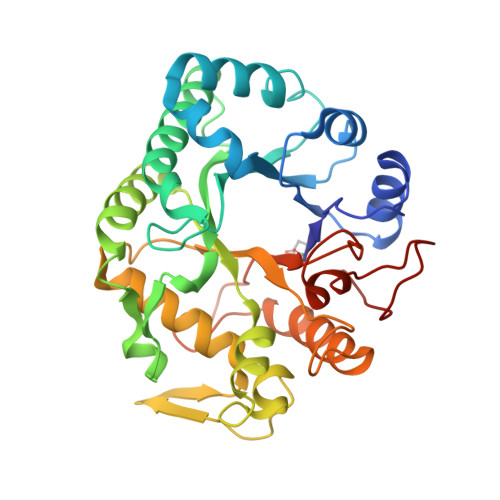Structural analysis of the endogenous glycoallergen Hev b 2 (endo-beta-1,3-glucanase) from Hevea brasiliensis and its recognition by human basophils.
Rodriguez-Romero, A., Hernandez-Santoyo, A., Fuentes-Silva, D., Palomares, L.A., Munoz-Cruz, S., Yepez-Mulia, L., Orozco-Martinez, S.(2014) Acta Crystallogr D Biol Crystallogr 70: 329-341
- PubMed: 24531467
- DOI: https://doi.org/10.1107/S1399004713027673
- Primary Citation of Related Structures:
4HPG, 4IIS - PubMed Abstract:
Endogenous glycosylated Hev b 2 (endo-β-1,3-glucanase) from Hevea brasiliensis is an important latex allergen that is recognized by IgE antibodies from patients who suffer from latex allergy. The carbohydrate moieties of Hev b 2 constitute a potentially important IgE-binding epitope that could be responsible for its cross-reactivity. Here, the structure of the endogenous isoform II of Hev b 2 that exhibits three post-translational modifications, including an N-terminal pyroglutamate and two glycosylation sites at Asn27 and at Asn314, is reported from two crystal polymorphs. These modifications form a patch on the surface of the molecule that is proposed to be one of the binding sites for IgE. A structure is also proposed for the most important N-glycan present in this protein as determined by digestion with specific enzymes. To analyze the role of the carbohydrate moieties in IgE antibody binding and in human basophil activation, the glycoallergen was enzymatically deglycosylated and evaluated. Time-lapse automated video microscopy of basophils stimulated with glycosylated Hev b 2 revealed basophil activation and degranulation. Immunological studies suggested that carbohydrates on Hev b 2 represent an allergenic IgE epitope. In addition, a dimer was found in each asymmetric unit that may reflect a regulatory mechanism of this plant defence protein.
Organizational Affiliation:
Instituto de Química, Universidad Nacional Autónoma de México, Circuito Exterior, CU, 04310 Coyoacán, DF, Mexico.


















